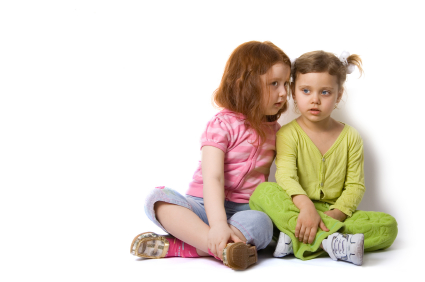 When my daughter entered fourth grade, the classroom dynamics got off to a bumpy start. A few strong personalities — and a new girl jockeying to fit in — led to small conflicts that lasted all year long.
When my daughter entered fourth grade, the classroom dynamics got off to a bumpy start. A few strong personalities — and a new girl jockeying to fit in — led to small conflicts that lasted all year long.
In May, the principal called to tell me my daughter and a few other girls were at risk of suspension for that day’s recess if they didn’t clean up their act. Apparently two small groups had volleyed glares that felt intimidating to younger children. It was the proverbial straw. When my daughter arrived home, I said, “Sounds like school was a little rough today.”
She burst into tears. She had never been in trouble at school.
Most parents associate girl conflicts — and mean-girl tactics — with the middle school years. But conduct known as “relational aggression” (what we think of as “mean girls” behavior) starts much younger. This is the behavior we see when kids manipulate others through friendship withdrawal, silent treatment and gossip.
A 2010 study from the State University of New York at Buffalo of children ages 3–12 found that some girls understand relationally aggressive tactics as early as preschool. It also reports that girls associate these tactics with being a girl. In other words, they expect to handle conflict with relational aggression — while boys associate physical aggression with being male.
Around second grade, this kind of behavior becomes more sophisticated, and teachers begin to see it in the classroom. “If a girl doesn’t color as neatly, wear the right clothes or can’t do something as well, a second-grader is just as likely to notice as a fifth-grader or a middle schooler,” says Dawn Christiana, a Bellingham elementary teacher. Also beginning in second grade, girls interact more than the younger girls, she says, and become more vocal. “Thus begin the cliques,” says Christiana.
What’s normal?
Social conflict in elementary school is not new. In fact, conflict among classmates and friends is a normal part of childhood, and parents shouldn’t fear it, says Cubba Reese, a parent educator in the greater Seattle area.
What is new? The social pressures girls face today. Roni Cohen-Sandler, Ph.D., author of Easing Their Stress: Helping our Girls Thrive in the Age of Pressure and a longtime psychologist, sees social behaviors in elementary-age girls that used to begin in middle school. Both biology and evolving cultural patterns are contributing to these changes, she says, through earlier physical maturity, exposure to media that portrays relational aggression, more marketing to younger girls and more pressure to achieve academically. As a result, she says, young girls are increasingly anxious, self-conscious and competitive.
Combine these pressures with the cultural message to girls to play nice (that is, avoid “challenging” emotions such as anger, resentment or jealousy), and social competition among elementary-age girls looks adolescent.
JoAnn Deak, Ph.D., author of Girls Will Be Girls, suggests teaching social conflict management skills at younger ages. By middle school, says Deak, the social patterns are habits, and habits are difficult to change.
 Managing pressures
Managing pressures
So how do we help our daughters manage social pressures and conflict? It starts with building strong connections at home, say experts. Here are some ideas for ways parents can help their girls navigate the new school year:
Empathize. If your daughter comes home fuming about a situation, the first step is to empathize — listen without judging or offering advice. When you empathize, you’re modeling a skill she needs to learn, as well as creating connection that’s important for your relationship, says Cohen-Sandler. Remember: Empathizing isn’t asking leading questions that imply she’s been wronged.
“It’s important to keep your own indignation in check. You shouldn’t be more upset than she is,” says Reese.
Validate a range of emotions. Girls need to know that all emotions, positive and negative, are normal and that “bad emotions” don’t make girls bad. Allowing your daughter’s anger or resentment to play out will help her calm down more quickly than if you minimize the situation, leap to solving the problem or suggest her feelings are unkind. Try something like, “Wow, you are spitting nails, you’re so mad,” says Reese.
Help her gain perspective. Media experiences can be effective springboards for important discussions about what someone might be feeling or thinking. When you’re watching a movie together or reading a book, talk about characters’ choices, including feelings, motives and behavior, says Cohen-Sandler. Fiction isn’t as emotionally loaded as discussing a fight with a friend. Seattle parent Alison Krupnick began a mother-daughter book club when her girls were young as a way to discuss friendship and conflict.
Help her to identify assumptions. It’s normal to make assumptions about other people’s actions, but it’s important to verify them, says Deak. Girls typically don’t like feeling uncomfortable emotions, and it’s much easier to whisper to a friend than to ask someone why she did such and such. But getting clarity is important, and girls needn’t be confrontational. “Try something like, ‘When you said I couldn’t sit here, I was just wondering why,’” suggests Deak.
Discuss possible reasons for another child’s behavior — that will help your daughter see she might have misunderstood the situation. Ask her about the girl’s tone of voice or expression on her face and say, “That’s one possibility. What else could cause those things to happen?”
Brainstorm problem-solving. Girls need practice moving from feeling to thinking to become problem solvers. Let your daughter think through the problem before offering help. Get her started with “I wonder what you can do” or “Do you have any ideas?” If she’s stuck, Reese suggests these phrases: “Would you like me to help you think this through?” or “I have one thought; would you like to hear it?” If she says no, don’t push it.
Keep in mind “our primary job is not to resolve the problem, but to give the message that girls are resilient and needn’t be afraid of conflict,” says Reese. “Our job is to empathize, to acknowledge the conflict and to give the message that friendships last through conflict.”
Tempting as it is to shut down the drama, listening to your daughter and helping her solve challenges will arm her with the emotional skills to tackle bumpy situations with real solutions. These skills will stay with her for life.
Bellingham writer Joanna Nesbit remembers fourth grade being hard, even back in the day. Learn more about her writing at joannanesbit.com.
Connecting with kids
- If you feel anxious when your daughter has an argument or when she’s angry with you, you may not be comfortable with challenging emotions. Say, “I can see you’re really mad at me; I want to hear why.” Practice empathizing so both of you experience moving through uncomfortable feelings in a healthy way.
- Try to be an unflappable presence. If you tend to overreact, judge or fix problems, your daughter will learn not to trust your views. Worrying about what other parents think can influence how we handle our kids’ feelings; ignore that little voice.
- Spend time with your daughter, tune in and share activities she likes. Creating true connection helps “inoculate girls against being inauthentic,” says Cohen-Sandler. It also sets up a positive dynamic for when she’s older and coping with bigger challenges.
- Make sure she knows you admire her for who she is, not what she does, Reese suggests. Girls feel enough outside pressure to perform well, and home should be a place to be themselves.
- As a family, take a break from screens to get away from the advertising and social media that can create insecurity and competition. Engage in old-school activities for healthy fun.











